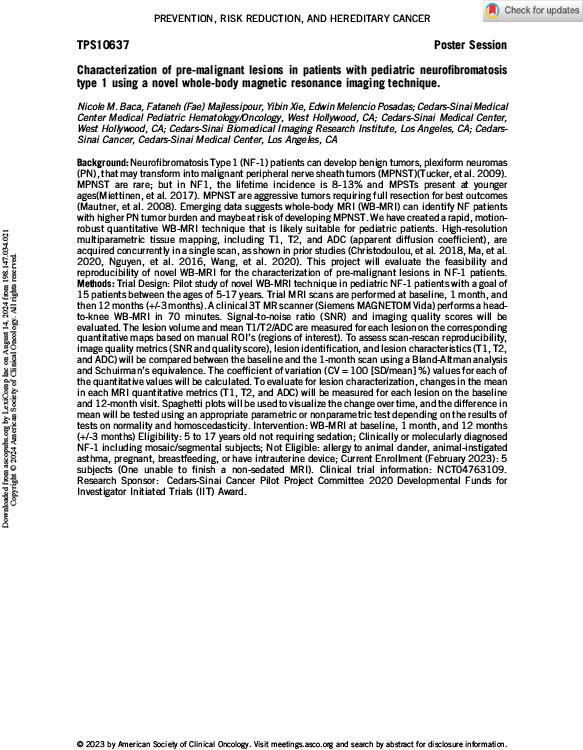Characterization of pre-malignant lesions in patients with pediatric neurofibromatosis type 1 using a novel whole-body magnetic resonance imaging technique.
May 2023
Background: Neurofibromatosis Type 1 (NF-1) patients can develop benign tumors, plexiform neuromas (PN), that may transform into malignant peripheral nerve sheath tumors (MPNST)(Tucker, et al. 2009). MPNST are rare; but in NF1, the lifetime incidence is 8-13% and MPSTs present at younger ages(Miettinen, et al. 2017). MPNST are aggressive tumors requiring full resection for best outcomes (Mautner, et al. 2008). Emerging data suggests whole-body MRI (WB-MRI) can identify NF patients with higher PN tumor burden and maybe at risk of developing MPNST. We have created a rapid, motion-robust quantitative WB-MRI technique that is likely suitable for pediatric patients. High-resolution multiparametric tissue mapping, including T1, T2, and ADC (apparent diffusion coefficient), are acquired concurrently in a single scan, as shown in prior studies (Christodoulou, et al. 2018, Ma, et al. 2020, Nguyen, et al. 2016, Wang, et al. 2020). This project will evaluate the feasibility and reproducibility of novel WB-MRI for the characterization of pre-malignant lesions in NF-1 patients. Methods: Trial Design: Pilot study of novel WB-MRI technique in pediatric NF-1 patients with a goal of 15 patients between the ages of 5-17 years. Trial MRI scans are performed at baseline, 1 month, and then 12 months (+/-3 months). A clinical 3T MR scanner (Siemens MAGNETOM Vida) performs a head-to-knee WB-MRI in 70 minutes. Signal-to-noise ratio (SNR) and imaging quality scores will be evaluated. The lesion volume and mean T1/T2/ADC are measured for each lesion on the corresponding quantitative maps based on manual ROI’s (regions of interest). To assess scan-rescan reproducibility, image quality metrics (SNR and quality score), lesion identification, and lesion characteristics (T1, T2, and ADC) will be compared between the baseline and the 1-month scan using a Bland-Altman analysis and Schuirman’s equivalence. The coefficient of variation (CV = 100 [SD/mean] %) values for each of the quantitative values will be calculated. To evaluate for lesion characterization, changes in the mean in each MRI quantitative metrics (T1, T2, and ADC) will be measured for each lesion on the baseline and 12-month visit. Spaghetti plots will be used to visualize the change over time, and the difference in mean will be tested using an appropriate parametric or nonparametric test depending on the results of tests on normality and homoscedasticity. Intervention: WB-MRI at baseline, 1 month, and 12 months (+/-3 months) Eligibility: 5 to 17 years old not requiring sedation; Clinically or molecularly diagnosed NF-1 including mosaic/segmental subjects; Not Eligible: allergy to animal dander, animal-instigated asthma, pregnant, breastfeeding, or have intrauterine device; Current Enrollment (February 2023): 5 subjects (One unable to finish a non-sedated MRI).

